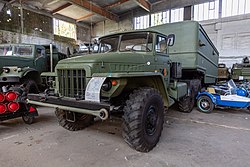Ural-377S
| Ural | |
|---|---|
|
Ural-377S with semi-trailer from the holdings of the former NVA (2018)
|
|
| Ural-377S | |
| Manufacturer: | Uralsky Avtomobilny Zavod |
| Sales designation: | Урал-377С |
| Production period: | 1965-1983 |
| Previous model: | none |
| Successor: | Urals-4420 |
| Technical specifications | |
| Designs: | Tractor unit |
| Engines: | V8 petrol engine |
| Power: | 132 kW |
| Payload: | 7.5 t |
| Perm. Total weight: | 14.6 t |
The Ural-377S ( Russian Урал-377С ) is a Soviet truck manufactured by the Uralsky Avtomobilny Zavod . The heavy three-axle tractor unit is a variant of the Ural-377 and was produced in series from 1965. In contrast to the widespread Ural-375 , the vehicle has no all-wheel drive , but a higher payload. During the almost 20 years of production, only around 2,300 units of the truck were built, around 30 of which found their way to the armed forces of the GDR . In 1983 production was stopped and from then on only semitrailer tractors with all-wheel drive were manufactured.
Vehicle history

Even during the development of the Ural-375 in the second half of the 1950s, prototypes without all-wheel drive were made, which were given the designation NAMI -022. Series production of these vehicles began under the designation Ural-377 in 1965. In this context, tractor units were also produced, which were given the type designation Ural-377S. Work on these prototypes began in Uralsky Avtomobilny Zavod in 1962. The cabin of the original Ural-375 without a fixed roof and with a soft top was still used for the first vehicles.
The first 50 production vehicles of the Ural-377S type were built in 1965 without the otherwise mandatory approval of the competent Soviet authorities. They already received the all-metal cabin of the Ural-375D. The main differences to the Ural-375S (and thus the tractor unit based on the Ural-375) were the lack of all-wheel drive and the lack of a tire pressure control system . Only the two rear axles are powered. Compared to the all-wheel drive version, structural changes were made to the vehicle frame, increasing the fifth wheel load from around 5 to 7.5 tons. In this way, the towed semi-trailers could weigh up to 18.5 tons, 6 tons more than the all-wheel drive version.
In the course of the production time, various prototypes were made, which differed only slightly from the basic model and did not go into series. Among them was the Ural-377MS, which got different tires and had a higher payload. Similar changes were made to the Ural-377SN model, which, however, was built in parallel to the basic version from 1975 and renamed Ural-377SNM in 1982. The series production of the Ural-377S and its variants was stopped in 1983 after only 2300 copies. The successor was the Ural-4420 with a more economical diesel engine , which was manufactured in parallel from 1980 .
The Ural-377S also came to the National People's Army and thus to the German Democratic Republic . It was used to a limited extent where semitrailers only had to be moved in easy terrain. When the Bundeswehr took over the NVA inventory in 1990, 29 copies were still available.
Technical specifications
For the production vehicles of the Ural-377S from 1965.
- Engine: four-stroke V8 petrol engine , water-cooled
- Engine type: ZIL-375, identical to that in the Ural-375
- Power: 180 hp (132 kW) at 3,200 min -1
- Torque: 466 Nm at 1800 min -1
- Displacement: 6962 cm³
- Bore: 108.0 mm
- Stroke: 95.0 mm
- Compression: 6.5: 1
- Firing order: 1-5-4-2-6-3-7-8
- Tank capacity: 300 l
- Fuel: petrol, at least 76 octane
- Consumption: 58 l / 100 km (standard consumption)
- Clutch: two-disc dry clutch
- Transmission: five-speed mechanical transmission with reverse gear
- Top speed: 60 km / h, also stated 65 km / h
- On-board voltage: 12 V.
- Drive formula : 6 × 4
Dimensions and weights
- Length: 6950 mm
- Width: 2500 mm
- Height: 2620 mm
- Wheelbase: 3500 + 1400 mm
- Front track: 2000 mm
- Rear track: 2000 mm
- Empty weight: 6830 kg
- Payload: 7500 kg (fifth wheel load)
- permissible total weight: 14,560 kg
- Front axle load: 3650 kg
- Rear axle load (double axle): 10,910 kg
- permissible total weight of the trailer: 18,500 kg
- permissible total weight of the truck combination: 25,530 kg
- Ground clearance: 320 mm
- Turning circle: 22 m
- Tire size: 14.00-20 ″
Individual evidence
- ↑ On the history of the Ural-377 on denisoviet.ru (Russian)
- ↑ a b c For the history of the Ural-377S on denisoviet.ru (Russian)
- ↑ a b c d Ralf Kunkel: Type compass GDR trucks. Imports from the USSR . P. 48 f.
- ↑ On the history of the Ural-377MS on denisoviet.ru (Russian)
- ↑ On the history of the Ural-377SN and its successor on denisoviet.ru (Russian)
- ^ Ministry of Automobile Transport of the RSFSR ; Vehicle Construction Institute NIIAT: Short Automobile Manual (краткий автомобильный справочник). P. 169 ff.
literature
- Ralf Kunkel: GDR truck type compass. Imports from the USSR . Motorbuch Verlag Stuttgart, 1st edition 2015, ISBN 978-3-613-03799-1 .
- LM Shugurov: АВТОМОБИЛИ России и СССР. Second part. Ilbi / Prostreks, Moscow 1994, ISBN 5-87483-006-5 .
- Ministry of Automobile Transport of the RSFSR ; Vehicle Construction Institute NIIAT: Short Automobile Manual (краткий автомобильный справочник). Transport Publishing House, 6th edition, Moscow 1971.



